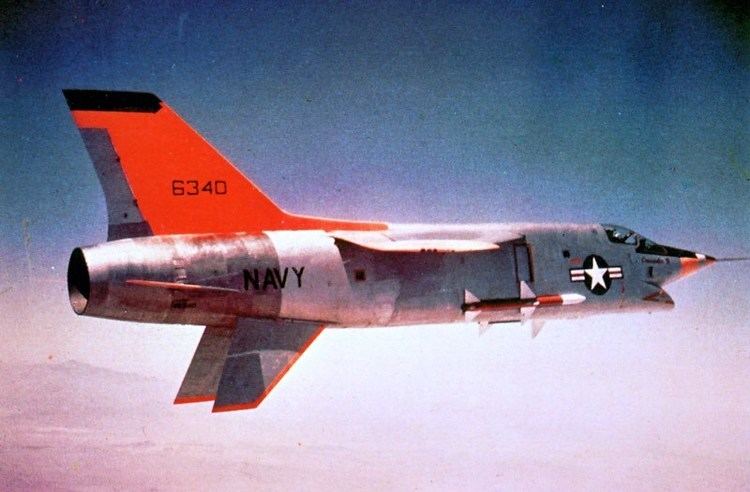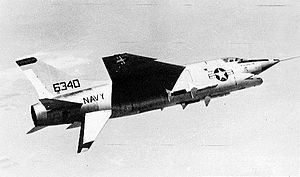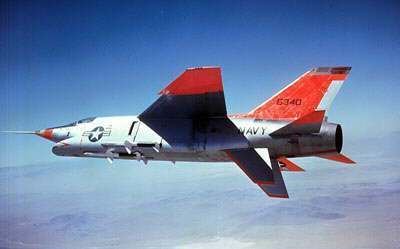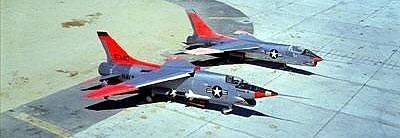Top speed 2,928 km/h Wingspan 12 m Cruise speed 925 km/h First flight June 2, 1958 | Range 1,040 km Length 18 m Engine type Pratt & Whitney J75 | |
 | ||
Vought xf8u 3 crusader iii
The Vought XF8U-3 Crusader III was an aircraft developed by Chance Vought as a successor to the successful Vought F-8 Crusader program and as a competitor to the McDonnell Douglas F-4 Phantom II. Though based in spirit on the F8U-1 and F8U-2, and sharing the older aircraft's designation in the old Navy system, the two aircraft shared few parts.
Contents
- Vought xf8u 3 crusader iii
- Grumman a 6 intruder a 7 corsair ii vought xf8u 3 crusader iii
- Design and development
- Operational history
- Operators
- Specifications
- References

Grumman a 6 intruder a 7 corsair ii vought xf8u 3 crusader iii
Design and development

In parallel with the F8U-1s and -2s, the Crusader design team was also working on a larger aircraft with even greater performance, internally designated as the V-401. Although externally similar to the Crusader and sharing with it such design elements as the variable incidence wing, the new fighter was larger and was powered by the Pratt & Whitney J75-P-5A engine generating 29,500 lbf (131 kN) of afterburning thrust. To deal with Mach 2+ flight conditions it was fitted with large vertical ventral fins under the tail which rotated to the horizontal position for landing. To ensure sufficient performance, Vought made provisions for a Rocketdyne XLF-40 liquid-fueled rocket motor with 8,000 lbf (35.6 kN) of thrust in addition to the turbojet. Avionics included the AN/AWG-7 fire control computer, AN/APG-74 radar, and AN/ASQ-19 datalink. The system was expected to simultaneously track six and engage two targets.

Due to extensive changes as compared to the F8U-1, the F8U-2 was labeled by some as the "Crusader II", and as a result, the XF8U-3 was officially labeled "Crusader III."
Operational history

The XF8U-3 first flew on 2 June 1958. Despite claims by many books and articles that, during testing, the aircraft reached Mach 2.6 at 35,000 ft (10,670 m), in fact, the maximum speed reached (only once) was Mach 2.39, while normal operating speed was no more than Mach 2.32. The first time that the aircraft exceeded Mach 2.0 in level flight was on August 14, during its 38th test flight, well before the rival F4H-1 did so. Some sources state that Vought projected a top speed of Mach 2.9 with the tail rocket installed, though the windscreen and most aluminum airframes were not designed to withstand the heat of speeds more than Mach 2.35. Demonstrated zoom ceiling was well over 76,000 ft (23,170 m). In December 1955, the US Navy declared a competition for a Mach 2+ fleet defense interceptor. Fly-offs against the Crusader III's main competitor, the future McDonnell Douglas F-4 Phantom II, demonstrated that the Vought design had a definite advantage in maneuverability. John Konrad, Vought's chief test pilot, later stated that the Crusader III could fly circles around the Phantom II. Combat thrust-to-weight ratio (T/W ratio) was almost unity (0.97), while early F4H had only 0.87. However, the solitary pilot in the XF8U-3 was easily overwhelmed with the workload required to fly the intercept and fire Sparrows which required constant radar illumination from the firing aircraft, while the Phantom II had a dedicated radar intercept officer on board.

In addition, with the perception that the age of the guns was over, the Phantom's considerably larger payload and the ability to perform air-to-ground as well as air-to-air missions, trumped Vought's fast but single-purposed fighter. For similar reasons, the Phantom would replace the Navy's F-8 Crusader as the primary daylight air superiority fighter in the Vietnam War, although it was originally introduced as a missile-armed interceptor to complement day fighters like the Crusader.
The F8U-3 program was canceled with five aircraft built. Three aircraft flew during the test program, and, along with two other airframes, were transferred to NASA for atmospheric testing, as the Crusader III was capable of flying above 95% of the Earth's atmosphere. NASA pilots flying at NAS Patuxent River routinely intercepted and defeated U.S. Navy Phantom IIs in mock dogfights, until complaints from the Navy put an end to the harassment.
All of the Crusader IIIs were later scrapped.
Operators
Specifications
Data from The Great Book of Fighters,American Fighter Aircraft, and MiG Master
General characteristics
Performance
Armament
Avionics
